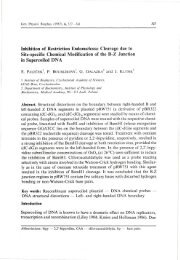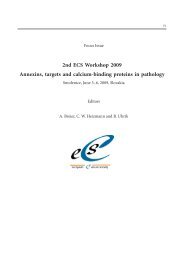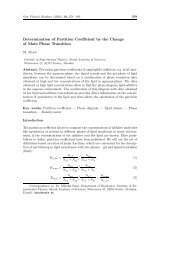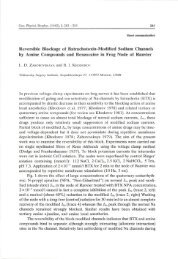Antidiabetic Effect of : Effect on Lipid Peroxidation in - Gpb.sav.sk
Antidiabetic Effect of : Effect on Lipid Peroxidation in - Gpb.sav.sk
Antidiabetic Effect of : Effect on Lipid Peroxidation in - Gpb.sav.sk
Create successful ePaper yourself
Turn your PDF publications into a flip-book with our unique Google optimized e-Paper software.
18 Pari and Latha<br />
Ellmans reagent (19.8 mg <str<strong>on</strong>g>of</str<strong>on</strong>g> 5,5’-dithiobisnitro benzoic acid <strong>in</strong> 100 ml <str<strong>on</strong>g>of</str<strong>on</strong>g> 0.1%<br />
sodium nitrate).<br />
GSH was determ<strong>in</strong>ed by the method <str<strong>on</strong>g>of</str<strong>on</strong>g> Ellman (1959). 1.0 ml <str<strong>on</strong>g>of</str<strong>on</strong>g> supernatant<br />
was treated with 0.5 ml <str<strong>on</strong>g>of</str<strong>on</strong>g> Ellmans reagent and 3.0 ml <str<strong>on</strong>g>of</str<strong>on</strong>g> phosphate buffer (0.2<br />
mol/l, pH 8.0). The absorbance was read at 412 nm. GPx activity was expressed<br />
as µg <str<strong>on</strong>g>of</str<strong>on</strong>g> GSH c<strong>on</strong>sumed/m<strong>in</strong>/mg prote<strong>in</strong> and reduced GSH as mg/100 g <str<strong>on</strong>g>of</str<strong>on</strong>g> tissue.<br />
Determ<strong>in</strong>ati<strong>on</strong> <str<strong>on</strong>g>of</str<strong>on</strong>g> GST<br />
The GST activity was determ<strong>in</strong>ed spectrophotometrically by the method <str<strong>on</strong>g>of</str<strong>on</strong>g> Habig<br />
et al. (1974). The reacti<strong>on</strong> mixture (3 ml) c<strong>on</strong>ta<strong>in</strong>ed 1.0 ml <str<strong>on</strong>g>of</str<strong>on</strong>g> 100 mmol/l phosphate<br />
buffer (pH 6.5), 0.1 ml <str<strong>on</strong>g>of</str<strong>on</strong>g> 30 mmol/l 1-chloro-2,4-d<strong>in</strong>itrobenzene (CDNB) and 1.7<br />
ml <str<strong>on</strong>g>of</str<strong>on</strong>g> double distilled water. After pre-<strong>in</strong>cubat<strong>in</strong>g the reacti<strong>on</strong> mixture at 37 ◦ Cfor<br />
5 m<strong>in</strong>, the reacti<strong>on</strong> was started by the additi<strong>on</strong> <str<strong>on</strong>g>of</str<strong>on</strong>g> 0.1 ml <str<strong>on</strong>g>of</str<strong>on</strong>g> tissue homogenate and<br />
0.1 ml <str<strong>on</strong>g>of</str<strong>on</strong>g> GSH as substrate. The absorbance was followed for 5 m<strong>in</strong> at 340 nm.<br />
Reacti<strong>on</strong> mixture without the enzyme was used as blank. The activity <str<strong>on</strong>g>of</str<strong>on</strong>g> GST was<br />
expressed as mmoles <str<strong>on</strong>g>of</str<strong>on</strong>g> GSH-CDNB c<strong>on</strong>jugate formed/m<strong>in</strong>/mg prote<strong>in</strong> us<strong>in</strong>g an<br />
ext<strong>in</strong>cti<strong>on</strong> coefficient <str<strong>on</strong>g>of</str<strong>on</strong>g> 9.6 (mmol/l) −1 .<br />
Estimati<strong>on</strong> <str<strong>on</strong>g>of</str<strong>on</strong>g> prote<strong>in</strong><br />
Prote<strong>in</strong> was determ<strong>in</strong>ed by the method <str<strong>on</strong>g>of</str<strong>on</strong>g> Lowry et al. (1951) us<strong>in</strong>g bov<strong>in</strong>e serum<br />
album<strong>in</strong> as standard, at 660 nm.<br />
Statistical analysis<br />
The data for various biochemical parameters were analysed us<strong>in</strong>g ANOVA and the<br />
group means were compared by Duncans multiple range test (DMRT). Values were<br />
c<strong>on</strong>sidered statistically significant when p < 0.05 (Duncan 1957).<br />
Results<br />
In all groups prior to streptozotoc<strong>in</strong> adm<strong>in</strong>istrati<strong>on</strong>, the basal levels <str<strong>on</strong>g>of</str<strong>on</strong>g> blood glucose<br />
<str<strong>on</strong>g>of</str<strong>on</strong>g> the rats were not significantly different. However, 48 h after streptozotoc<strong>in</strong><br />
adm<strong>in</strong>istrati<strong>on</strong>, blood glucose levels were significantly higher <strong>in</strong> rats selected for<br />
the study. In c<strong>on</strong>trast, n<strong>on</strong>-diabetic c<strong>on</strong>trols rema<strong>in</strong>ed persistently euglycaemic<br />
throughout the course <str<strong>on</strong>g>of</str<strong>on</strong>g> the study.<br />
Table 1 shows the effect <str<strong>on</strong>g>of</str<strong>on</strong>g> treatment with extracts <strong>on</strong> blood glucose levels.<br />
In all the SPEt-treated groups (all doses) a significant antihyperglycaemic (p <<br />
0.01) effect was evident from first week <strong>on</strong>wards the decrease <strong>in</strong> blood sugar be<strong>in</strong>g<br />
maximum <strong>on</strong> completi<strong>on</strong> <str<strong>on</strong>g>of</str<strong>on</strong>g> the third week (66.5%, p < 0.001) <strong>in</strong> the group receiv<strong>in</strong>g<br />
200 mg/kg/day <str<strong>on</strong>g>of</str<strong>on</strong>g> aqueous SPEt. On the other hand, ethanolic- and chlor<str<strong>on</strong>g>of</str<strong>on</strong>g>orm<br />
extracts-treated groups showed an antihyperglycaemic effect much later (i.e. <strong>on</strong><br />
completi<strong>on</strong> <str<strong>on</strong>g>of</str<strong>on</strong>g> the third week) <strong>in</strong> groups receiv<strong>in</strong>g 200 mg/kg per day (60.5 and<br />
56.3%, respectively). On the basis <str<strong>on</strong>g>of</str<strong>on</strong>g> these studies, doses <str<strong>on</strong>g>of</str<strong>on</strong>g> 200 mg/kg per day <str<strong>on</strong>g>of</str<strong>on</strong>g><br />
aqueous, SPEt was selected for further evaluati<strong>on</strong>.









